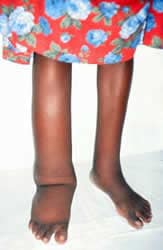Disease

Patient with lymphedema. (CDC Photo)
Although the parasite damages the lymph system , most infected people have no symptoms and will never develop clinical symptoms. These people do not know they have lymphatic filariasis unless tested. A small percentage of persons will develop lymphedema. This is caused by fluid collection because of improper functioning of the lymph system resulting in swelling. This mostly affects the legs, but can also occur in the arms, breasts, and genitalia. Most people develop these symptoms years after being infected.
The swelling and the decreased function of the lymph system make it difficult for the body to fight germs and infections. These people will have more bacterial infections in the skin and lymph system. This causes hardening and thickening of the skin, which is called elephantiasis. Many of these bacterial infections can be prevented with appropriate skin hygiene as well as skin and wound care .
Men can develop hydrocele or swelling of the scrotum due to infection with one of the parasites that causes LF specifically W. bancrofti.
Filarial infection can also cause tropical pulmonary eosinophilia syndrome, although this syndrome is typically found in persons living with the disease in Asia. Eosinophilia is the presence of higher than normal disease-fighting white blood cells in the body. Symptoms of tropical pulmonary eosinophilia syndrome include cough, shortness of breath, and wheezing. The eosinophilia is often accompanied by high levels of Immunoglobulin E ( IgE) and antifilarial antibodies.